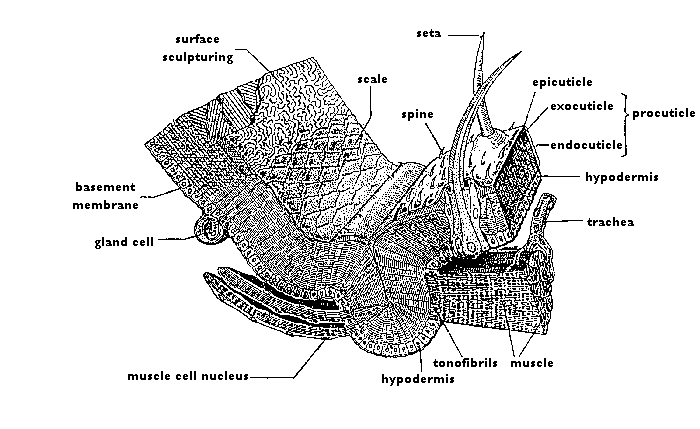 Back to Opiliones Notes
Back to Opiliones Notes Back to Opiliones Notes
Back to Opiliones Notes |
Back to Classification
Page |
Key feature is presence of cuticle (exoskeleton), super-imposed
on metameric segmentation inherited from their annelidan ancestors ,
plus development of jointed limbs for locomotion and other uses.
The cuticle is mainly composed of a protein (sclerotin) and a polysaccharide (chitin).
Generally, the two thickest layers are the endocuticle and exocuticle.
The endocuticle is the innermost layer,
outside of which is the exocuticle where hardening takes place to give
the rigidity of the cuticle.
These two layers are sometimes referred to jointly as the procuticle.
The very thin outermost layer is the epicuticle, which is important
as it provides a tough protective covering
and in terrestrial species has a waterproof layer of wax.
The tremendous advantages conferred by these adaptations led to
tremendous success of arthropods, both in terms of population sizes (numbers
of individuals) and diversity (number of species).
The three main arthropodan phyla - Crustacea,
Chelicerata, Uniramia - had separate evolutionary origins and are
not related to each other but show an amazing number of analogous features
as a result of convergent evolution - the result of having a cuticle.
Crustacea - cuticle hardened by deposition of calcium salts; evolved in the sea and still predominantly marine organisms.
Chelicerata - cuticle hardened by formation of disulphide links between polypeptide chains; evolved in the sea (Merostomata) but now almost entirely terrestrial (Arachnida, e.g. spiders).
Uniramia - cuticle hardened by quinone bonds betwen polypeptide
chains; evolved on land and now extremely successful terrestrial animals,
with a few secondarily adapted to aquatic life.
Adaptation and Evolution
These concepts for the arthropods can be well considered alongside
the general theme of "adaptation", with its three types (universal, physiological
and evolutionary) and the concept of key adaptations in the evolution of
major groups.
 |
Back to Opiliones Notes | or | Back to Arachnologia |
 |
Back to Home page |